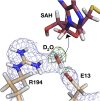Neutron structures of the Helicobacter pylori 5'-methylthioadenosine nucleosidase highlight proton sharing and protonation states
- PMID: 27856757
- PMCID: PMC5137710
- DOI: 10.1073/pnas.1609718113
Neutron structures of the Helicobacter pylori 5'-methylthioadenosine nucleosidase highlight proton sharing and protonation states
Abstract
MTAN (5'-methylthioadenosine nucleosidase) catalyzes the hydrolysis of the N-ribosidic bond of a variety of adenosine-containing metabolites. The Helicobacter pylori MTAN (HpMTAN) hydrolyzes 6-amino-6-deoxyfutalosine in the second step of the alternative menaquinone biosynthetic pathway. Substrate binding of the adenine moiety is mediated almost exclusively by hydrogen bonds, and the proposed catalytic mechanism requires multiple proton-transfer events. Of particular interest is the protonation state of residue D198, which possesses a pKa above 8 and functions as a general acid to initiate the enzymatic reaction. In this study we present three corefined neutron/X-ray crystal structures of wild-type HpMTAN cocrystallized with S-adenosylhomocysteine (SAH), Formycin A (FMA), and (3R,4S)-4-(4-Chlorophenylthiomethyl)-1-[(9-deaza-adenin-9-yl)methyl]-3-hydroxypyrrolidine (p-ClPh-Thio-DADMe-ImmA) as well as one neutron/X-ray crystal structure of an inactive variant (HpMTAN-D198N) cocrystallized with SAH. These results support a mechanism of D198 pKa elevation through the unexpected sharing of a proton with atom N7 of the adenine moiety possessing unconventional hydrogen-bond geometry. Additionally, the neutron structures also highlight active site features that promote the stabilization of the transition state and slight variations in these interactions that result in 100-fold difference in binding affinities between the DADMe-ImmA and ImmA analogs.
Keywords: Helicobacter; enzyme mechanism; neutron diffraction; nucleosidase; proton transfer.
Conflict of interest statement
The authors declare no conflict of interest.
Figures







Similar articles
-
Molecular dynamics study of the effect of active site protonation on Helicobacter pylori 5'-methylthioadenosine/S-adenosylhomocysteine nucleosidase.Eur Biophys J. 2015 Dec;44(8):685-96. doi: 10.1007/s00249-015-1067-0. Epub 2015 Aug 8. Eur Biophys J. 2015. PMID: 26254213
-
Crystal structures of the Helicobacter pylori MTAN enzyme reveal specific interactions between S-adenosylhomocysteine and the 5'-alkylthio binding subsite.Biochemistry. 2012 Dec 4;51(48):9763-72. doi: 10.1021/bi301221k. Epub 2012 Nov 20. Biochemistry. 2012. PMID: 23148563 Free PMC article.
-
Transition State Structure and Inhibition of Rv0091, a 5'-Deoxyadenosine/5'-methylthioadenosine Nucleosidase from Mycobacterium tuberculosis.ACS Chem Biol. 2016 Jun 17;11(6):1669-76. doi: 10.1021/acschembio.6b00144. Epub 2016 Apr 8. ACS Chem Biol. 2016. PMID: 27019223 Free PMC article.
-
Neutron Crystallography for the Study of Hydrogen Bonds in Macromolecules.Molecules. 2017 Apr 7;22(4):596. doi: 10.3390/molecules22040596. Molecules. 2017. PMID: 28387738 Free PMC article. Review.
-
Hydrogen bonds and proton transfer in general-catalytic transition-state stabilization in enzyme catalysis.Biochim Biophys Acta. 2000 May 12;1458(1):43-62. doi: 10.1016/s0005-2728(00)00059-1. Biochim Biophys Acta. 2000. PMID: 10812024 Review.
Cited by
-
Metalloprotein catalysis: structural and mechanistic insights into oxidoreductases from neutron protein crystallography.Acta Crystallogr D Struct Biol. 2021 Oct 1;77(Pt 10):1251-1269. doi: 10.1107/S2059798321009025. Epub 2021 Sep 27. Acta Crystallogr D Struct Biol. 2021. PMID: 34605429 Free PMC article. Review.
-
Low barrier hydrogen bonds in protein structure and function.Biochim Biophys Acta Proteins Proteom. 2021 Jan;1869(1):140557. doi: 10.1016/j.bbapap.2020.140557. Epub 2020 Oct 23. Biochim Biophys Acta Proteins Proteom. 2021. PMID: 33148530 Free PMC article. Review.
-
Capturing the Catalytic Proton of Dihydrofolate Reductase: Implications for General Acid-Base Catalysis.ACS Catal. 2021 May 7;11(9):5873-5884. doi: 10.1021/acscatal.1c00417. Epub 2021 Apr 28. ACS Catal. 2021. PMID: 34055457 Free PMC article.
-
Neutron diffraction from a microgravity-grown crystal reveals the active site hydrogens of the internal aldimine form of tryptophan synthase.Cell Rep Phys Sci. 2024 Feb 21;5(2):101827. doi: 10.1016/j.xcrp.2024.101827. Epub 2024 Feb 12. Cell Rep Phys Sci. 2024. PMID: 38645802 Free PMC article.
-
Direct Observation of Protonation State Modulation in SARS-CoV-2 Main Protease upon Inhibitor Binding with Neutron Crystallography.J Med Chem. 2021 Apr 22;64(8):4991-5000. doi: 10.1021/acs.jmedchem.1c00058. Epub 2021 Mar 23. J Med Chem. 2021. PMID: 33755450 Free PMC article.
References
-
- Dairi T. An alternative menaquinone biosynthetic pathway operating in microorganisms: An attractive target for drug discovery to pathogenic Helicobacter and Chlamydia strains. J Antibiot (Tokyo) 2009;62(7):347–352. - PubMed
-
- Thomas K, et al. Femtomolar inhibitors bind to 5′-methylthioadenosine nucleosidases with favorable enthalpy and entropy. Biochemistry. 2012;51(38):7541–7550. - PubMed
Publication types
MeSH terms
Substances
Associated data
- Actions
- Actions
- Actions
- Actions
- Actions
Grants and funding
LinkOut - more resources
Full Text Sources
Other Literature Sources

